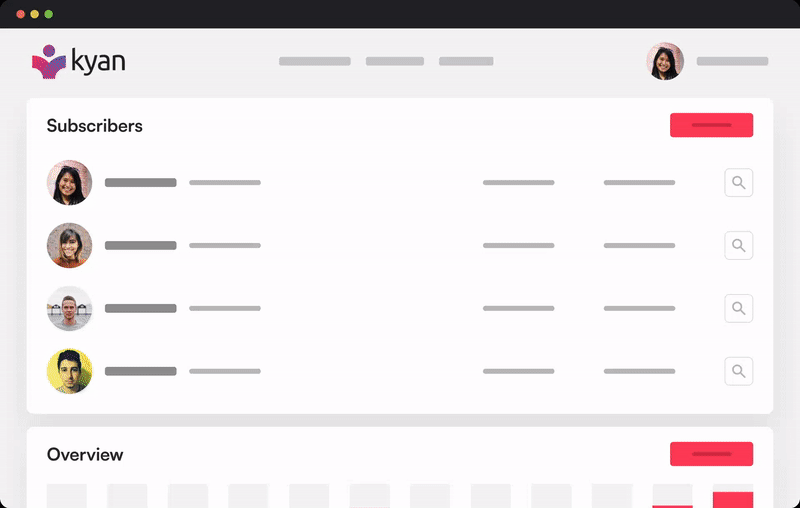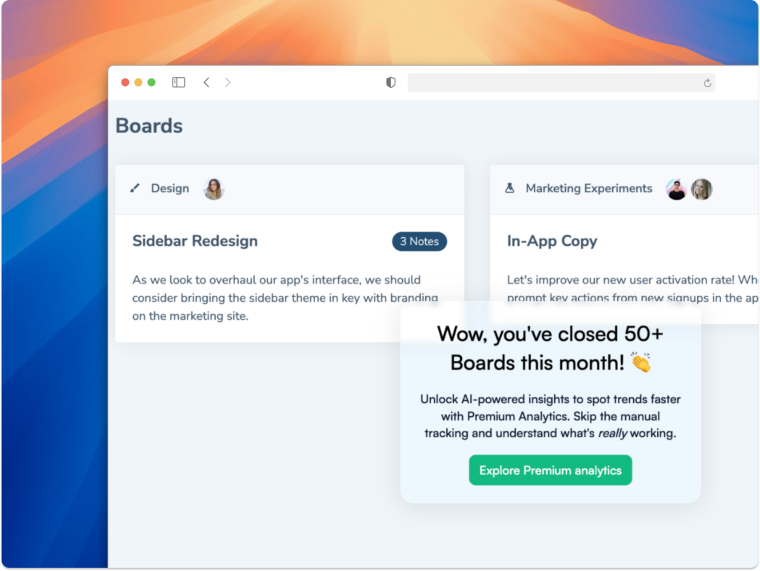In our recent UX Research Expert Roundtable webinar, we talked about everything from why companies should be democratizing research, to tying findings back to business value, and how to communicate internally to get your voice heard. Plus, we got some tasty nuggets of actionable advice that any UX Researcher can follow.
Chameleon’s Co-Founder and CEO, Pulkit Agrawal, joined in conversation with Roberta Dombrowski, VP User Research at User Interviews, Behzod Sirjani, Founder of Yet Another Studio and previous Head of Research at Slack, and Jaime Creixems, Design Advocate at Sketch, to discuss all things UX Research.
Here’s a webinar recap for you, packed with insights and tips. Let’s dive in!

🎬 UX Research Expert Roundtable
Prefer watching than reading? Watch the whole webinar right here 👇
The evolving role of a UX Researcher
The role of research may be done by a UX Researcher, Product Manager, or even a Designer, and expectations, roles, and goals will differ depending on the team, company size, and product.

Companies are organisms, so they’re constantly evolving and shifting. I joined User Interviews as the first Researcher, in the weeds myself. I’m now part of a team of three, and I’m less in the day-to-day of conducting research. We also have PMs and UI Designers doing research.
The role and tasks of a UX Researcher have expanded over time, and especially in the last few years with the growth of the SaaS industry. And why is it so important? At the heart, research helps decision-making for teams and de-risks high-level decisions.
Roberta Dombrowski shares her thoughts on how the role is evolving👇
Behzod Sirjani, Founder of Yet Another Studio and previous Head of Research at Slack, supports this, and explains the importance of building systems that allow the rest of the organization to do the work that they’re excited about and need to do.

People need to stop thinking about the outputs of their work as their primary contribution. We are going to be much more impactful by helping people understand how to get answers to the questions they’re making, so they can make better decisions.
How to build a holistic approach to user research
In larger companies, where you’re more likely to find all three roles of UX Researchers, Product Managers, and Designers, there’s no standard approach to working together.
This can make it challenging for Researchers to ensure their work is heard and fed back into the design and overall strategy. Here's how Jaime Creixems puts it.

Research has a very tangible outcome: you have findings, problems you’ve identified, a list of issues, and feature requests. With that, you have good things to measure. This data will give you the problem, but not the solution – that’s when you’ve got to incorporate your UX and UI Designers to turn these findings into an interesting and smart solution.
So what are some tactics to ensure research influences product, design, and company decisions?
1. Democratize research
Many companies are starting to champion the democratization of research – making it easy and acceptable for anyone in the company to access user research, and in some cases, to do it themselves.
It can be a challenge, and Behzod describes it as "balancing the burden of recognizing there’s so much going on that you can’t deal with, with opening up the practice and embracing the skills that others have in the organization.”
He emphasizes the importance of derisking the process by asking: “What are the things that researchers need to own and drive because they’re the ones that have the most trained hands to do that, vs where is it safe and accessible for other people to play? And what are the things that you can do structurally to derisk those things for them?”
Here’s how they did it at Slack...
Roberta champions humanizing the process to make it more accessible, and shares: "Once I start on a team, I always take time to get to know the stakeholders and build that relationship with everyone, and they realize that research isn’t that scary.”
Jaime describes how they do this at Sketch – with open sessions where they invite other designers from the company or clients, they ask questions but ensure to keep it an open space and let feedback turn into conversations that lead to great findings.
The way Jaime puts it: ”Including people and communicating is one of the most important parts of the process.” Here, he shares more 👇
2. Communicate for your audience
When involving another stakeholder, whether it’s a Product Manager, Designer, or someone in leadership, Researchers should think about the benefits and outcomes for that person, and communicate that.

I need to communicate in the terms that they care about and language they understand, for example: 'I can help you make a better decision, get more confidence, reduce the uncertainty that something is going to happen, reduce the number of options we’re evaluating.'
If researchers can make that mindset shift, they will quickly become less speaker-centric and more audience-centric, and level up the way that they communicate.
3. Ensure research sits where decisions are made
Research can sit across a variety of different functions, whether it be product or design. But Researchers should ensure they work with the people who make decisions, so they can have influence, and drive the biggest amount of impact.
Pro tips for collecting feedback and testing
How do they do user research at a world-famous user research company?
When deciding on the research method, the size of evidence you need matters – sometimes it’s not about a lengthy method or process, as you may just need a pulse check. As Behzod puts it: “There’s a difference between teams that just need a snack vs. a full feast!”
In this case, you could use an in-product survey to get quick feedback you need to make a decision.
Microsurveys can also be an effective tool for continuous discovery and building feedback loops, and they are particularly beneficial to:
Get contextual and relevant feedback from a user when they’re actually using the product
Give people a chance to give feedback at a time that’s convenient for them
💡 PLUS, Chameleon Microsurveys get triple the number of responses than email 💪
Read more in our latest Benchmark Report.
If you’re trying to build a research practice and system, you should pay attention to the types of decisions that are being made in a business.
Behzod suggests Researchers ask:
What are all the decisions that exist in the organization?
What are the ones you feel that you can impact?
What are the ones your partners know that you can impact?
And then, how do you increase the size of the overlap with those?
This may come through upskilling, hiring people with various skill sets, or pushing to make research more visible.
Jaime recommends the approaches he uses throughout the UX research process, and highlights the importance of the distinction between methods of discovering for the first time vs. when you’re testing and evaluating.
Tie it all together with the right tools
If you’re not careful, the amount of research you have can quickly become overwhelming. There can be a huge amount of it, gathered in various ways, and spread all over the place – across tools, on paper, and even still in people’s minds! So how can Researchers and product teams effectively aggregate this data to use it effectively?
The answer is great tooling.
For example, you can implement a tool like User Interviews to keep track of who you’re talking to, collect in-product, contextual user feedback with a tool like Chameleon, and use a simple product management tool like Notion to centralize everything and keep track of what you learn in one single, clear source of truth.
How did they do this at Slack?
How to measure the impact of research
The focal point should be around how the research findings bring business value. Ask yourself if you answered the questions you set out to, and if this information is being used in a company decision or not.
Some teams do things like count the number of studies conducted, or the number of research participants talked to. But these metrics are surface-level, and while they show that research is happening, they don’t show an impact on any decisions being made.

I keep a spreadsheet of all the big things. This year, our pricing model’s shifting and our go-to-market motion changed – those are huge things that my team helped lead and have an impact on. That’s the story – that’s the success I want to share with other people.
It’s also about reducing risk for the business. As Behzod puts it: “Every product you ship is basically a decision and a bet. So you should be asking: ‘What are we going to derisk?’ and presenting that back to the business."
It’s very easy to know when you’re not doing enough research, as Jaime adds: “If the product is growing, it’s hard to know that it’s research that’s driving this. But, if people aren’t happy, they keep asking for the same features over and over, or you keep getting bad reviews, then you know you’re not doing enough.”
Best UX Research resources recommended by our speakers
If you’d like to learn more about UX research and hone your research skills, here are some of the best reads that our Expert Roundtable guests recommend.
Behzod’s favorite book is The Field Study Handbook by Jan Chipchase because, as he describes it: “It teaches us how to look critically at the world, step away from your own perspectives, and understand what it means to engage others in that process.”
And, as his ultimate event, he recommends UXR Conf.
Jaime loves the book How to Talk So Kids Will Listen & Listen So Kids Will Talk by Adele Faber and Elaine Mazlish, for its useful tactics when conducting interviews, understanding users, and being empathetic. In Jaime’s words: “It’s transformed how I approach everything - both in research and design, and my personal relationships”.
Roberta’s top reads are Continuous Discovery Habits by Teresa Torres for learning research loops, and Design for How People Learn by Julie Dirksen for its approachable content around research enablement and education.
Our conversation comes to a close, let’s wrap it up
As we conclude, we hope you’ve learned a lot from our experts, and now feel more confident taking user research to the next level at your company – ensuring your findings bring business value and have a real impact on strategic product decisions.
Remember, using the right tools can help you organize better, speed up the process where needed, and uncover insights more quickly.

Create Microsurveys for continuous in-product feedback
Easily build no-code in-app surveys to collect contextual and targeted user feedback. Try for free.






